There are eight venomous snakes in Oklahoma. The list includes six rattlesnakes, two copperheads, and a cottonmouth.
The venomous snake species in Oklahoma are vital to the health of the state’s environment in that they help keep rodent populations under control. Each of these snakes is potentially dangerous, though. In fact, in an average year, 206 people are bitten by venomous snakes in Oklahoma.
It’s crucial for anyone who spends time in Oklahoma outdoors to learn about these dangerous snakes.
This guide will provide detailed profiles of Oklahoma’s venomous snake species. We’ll give detailed information on how to recognize them, how dangerous they are, and what environments they live in within Oklahoma.
Pit Vipers: The Venomous Masters of Infrared Detection
Rattlesnakes, Copperheads, and Cottonmouths are among the most well-known members of the venomous Crotalinae subfamily, also referred to as pit vipers. These snakes are equipped with unique adaptations that make them exceptional hunters.
What Makes Pit Vipers Unique?
- Infrared-Sensing Pits:
A defining feature of pit vipers is the deep facial pit between their nostril and the eye on each side of their head. These specialized infrared-detecting organs allow pit vipers to sense heat emitted by prey. This adaptation enables them to:- Detect body heat from up to 1 meter away.
- Strike prey with pinpoint accuracy, even in complete darkness.
- Triangular Heads and Vertical Pupils:
- Head Shape: Pit vipers are recognized by their distinct triangular-shaped heads, which house their venom glands.
- Eyes: They have vertical elliptical-shaped pupils.
- Venomous Fangs:
Pit vipers have hollow fangs connected to venom glands. These fangs fold back against the roof of their mouth when not in use.
Ecological Importance
Pit vipers play a crucial role in maintaining ecosystem balance by controlling rodent populations. Despite their fearsome reputation, these snakes are vital to the health of many habitats.
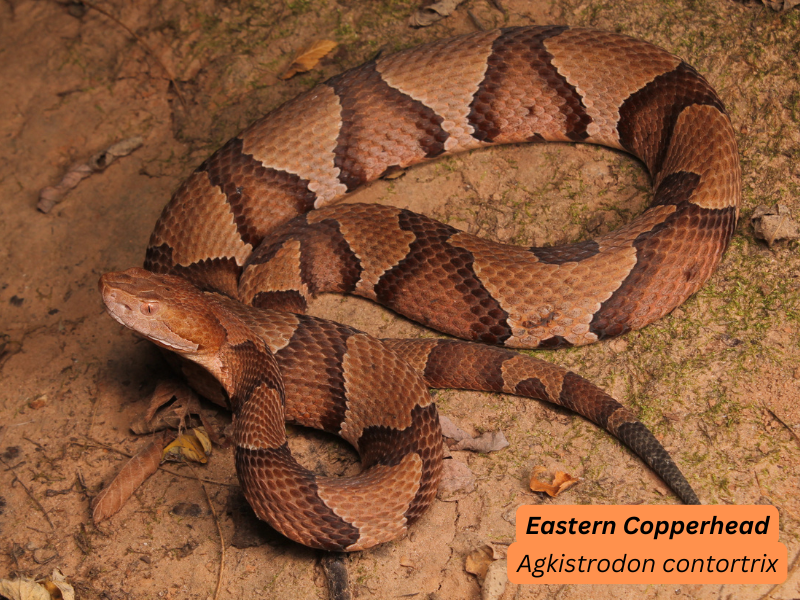
Eastern Copperhead (Agkistrodon contortrix)
The Eastern Copperhead is a pit viper native to the eastern United States.
What Do Eastern Copperheads Look Like?
| Coloration | *Reddish-tan to grayish-tan bodies. *Overlaid with dark brown, hourglass-shaped markings. *Heads are dark coppery brown, giving them the name “Copperhead.” |
| Body Shape | *Stout and heavy-bodied snakes. *As with all pitvipers, their heads are triangular and appear oversized in relation to their necks. |
| Size | *Adults range from 20 to 37 inches (50 to 95 cm) in length. |
| Conservation Status | *Common within their range in Oklahoma. |
Taxonomy of Oklahoma’s Eastern Copperhead Snakes
Copperhead snakes are found across most of Oklahoma and are now recognized as a single species: the Eastern Copperhead (Agkistrodon contortrix).
In the past, these snakes were classified into different subspecies, including the Northern Copperhead, Southern Copperhead, and Osage Copperhead. However, recent DNA studies revealed minimal genetic differences between them. As a result, these subspecies were combined into a single taxonomic group under the Eastern Copperhead name.
Where Do Eastern Copperheads Live in Oklahoma?
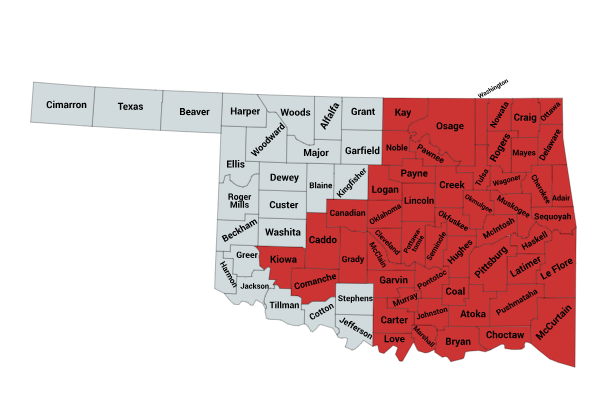
You will find the Eastern copperhead throughout the eastern half of Oklahoma. Look for them in lightly wooded areas. This includes deciduous forests, river bottoms, and rocky wooded hillsides. They utilize leaf litter, tall grass, and other plant debris for cover.
Eastern Copperhead Behavior
Copperheads are dangerous because they use camouflage as their number one defense mechanism. In other words, these snakes choose to lie perfectly still rather than flee most of the time. Their camouflage helps them blend in with leaf litter and other ground debris.
When they feel threatened, they occasionally mimic the tail vibration of a rattlesnake. But, in most cases, they choose to lie perfectly still.
Most copperhead bites on humans occur when the person steps on or near the snake.
What Do Copperheads Eat?
Copperhead snakes are opportunistic feeders. They eat insects, spiders, frogs, small rodents, birds, and other reptiles.
How Dangerous Are Copperheads?
A Copperhead can bite and inject venom from the time they are newly born. Like most pit vipers, they have hemotoxic venom.
Most copperhead bites are not life-threatening. On the other hand, any bite from this snake is a medical emergency and should be treated as such. Prompt medical attention increases the chance of a good outcome.
Copperhead bites can cause intense pain, shock, and swelling. Their bites also have the potential to cause blood in urine, tissue damage, and kidney failure.
An interesting study has found that Copperhead venom contains a protein called contortrostatin. Contortrostatin has been found to stop the growth of cancer cells in mice.
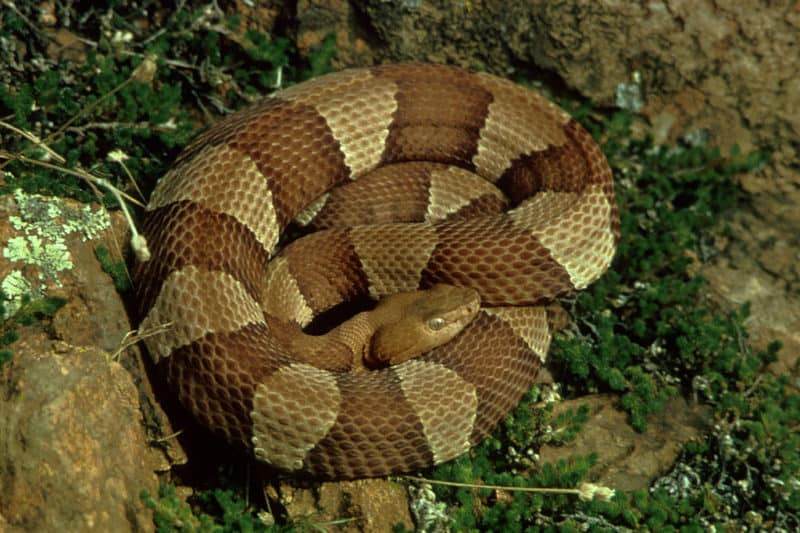
Broadbanded Copperhead (Agkistrodon c. laticinctus)
| Size | *Adult copperheads are 20 to 36 inches (50–90 cm) long. |
| Coloration | *Tan based bodies. *Overlaid with broad brown bands. *Broad bands vary by region from a grayish-brown to a reddish-brown. *Heads are dark coppery brown, giving them the name “Copperhead.” |
| Body Shape | *Stout and heavy-bodied snakes. *As with all pitvipers, their heads are triangular and appear oversized in relation to their necks. |
| Conservation Status: |
Where Do Broadbanded Copperheads Live in Oklahoma?
They are most prevalent in wooded areas close to a water source. They prefer areas where the leaf and plant debris offer them cover.
How Dangerous Are Copperheads?
A Copperhead can bite and inject venom from the time they are newly born. Like most pit vipers, they have hemotoxic venom.
Most copperhead bites are not life-threatening. On the other hand, any bite from this snake is a medical emergency and should be treated as such. Prompt medical attention increases the chance of a good outcome.
Copperhead bites can cause intense pain, shock, and swelling. Their bites also have the potential to cause blood in urine, tissue damage, and kidney failure.
An interesting study has found that Copperhead venom contains a protein called contortrostatin. Contortrostatin has been found to stop the growth of cancer cells in mice.
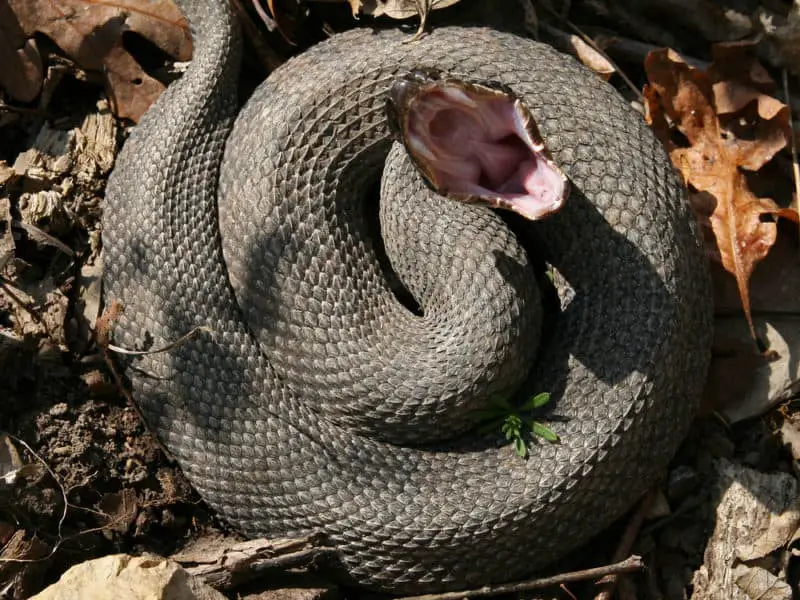
Northern Cottonmouth (Agkistrodon piscivorus)
Another common name for the Northern Cottonmouth is water moccasin. They look a little bit like rattlesnakes without the rattle on the tail. People also sometimes mistake them for common water snakes. This could be a dangerous mistake.
What Do Northern Cottonmouths Look Like?
| Coloration | *Adults: Dark brown to black body with minimal markings. *Inside of the mouth: White, giving them the name “cottonmouth.” *Juveniles: More defined patterns, resembling a copperhead with darker bands that widen toward the belly and narrow along the back. *Inside is pale pink to white, visible during their defensive open-mouthed pose (origin of the name “cottonmouth”). |
| Body Shape | *Stout, muscular snakes. |
| Size | *These snakes grow up to 3 feet (0.91 m) in length. |
| Behaviors | *Cottonmouths arc their heads upward and display an open-mouthed pose when agitated. This exposes the white interior of their mouth. This is a warning to back off or suffer the consequences. *Interestingly, they can hold their breath underwater for up to an hour while hunting for prey. |
| Distinctive Features | *Pupils are cat-like and elliptical, appearing as narrow slits during the day. At night, pupils appear round. |
| Conservation Status | *Common within their range in Oklahoma. |
Where Do Northern Cottonmouths Live in Oklahoma?
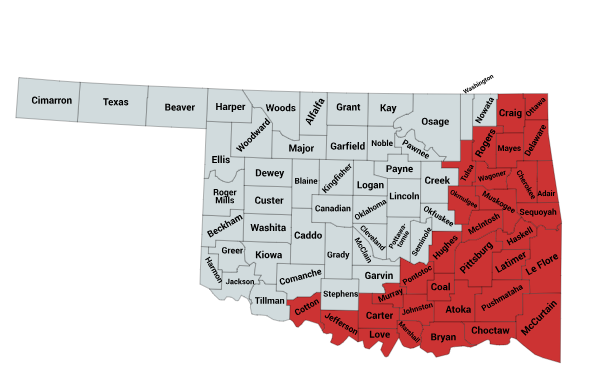
Cottonmouths are semi-aquatic snakes. They spend most of their time near swamps, marshes, rivers, and lakes. They can hold their breath underwater for up to an hour while hunting for prey. They are located in eastern Oklahoma.
What Do Northern Cottonmouths Eat?
These snakes prey on fish, freshwater crustaceans, amphibians, small mammals, and other reptiles. Cottonmouths sometimes congregate around drying wetland pools to feed on any trapped fish.
How Dangerous Are Northern Cottonmouths?
Northern Cottonmouth venom is cytotoxic. This means it destroys body tissue. Northern Cottonmouth bites sometimes lead to the amputation of limbs. On rare occasions, death can occur.
Wild Cats in Oklahoma – Krebs Creek
Scorpions in Oklahoma – Krebs Creek
Rattlesnakes of Oklahoma
Here’s a list of Oklahoma’s five rattlesnake species.
- Prairie Rattlesnake (Crotalus viridis)
- Western Massasauga (Sistrurus catenatus)
- Western Diamondback Rattlesnake (Crotalus atrox)
- Timber Rattlesnake (Crotalus horridus)
- Western Pygmy Rattlesnake (Sistrurus miliarius)
Rattlesnakes are pit vipers. See the description of pit vipers above.
What Oklahoma’s rattlesnakes have in common with most other rattlesnake species is their rattle.
- Most rattlesnakes have a rattle at their tail’s end, comprised of hollow, loosely interlocked keratinous scales.
- Normally, a rattlesnake adds a new segment to its rattle each time it sheds its skin.
- An agitated rattlesnake rapidly vibrates its tail, causing the segments of its rattle to vibrate together, creating a buzzing or rattling sound.
- Not all rattlesnakes rattle before they strike. Sometimes, they lose their rattles due to injury, and sometimes, they choose not to rattle.
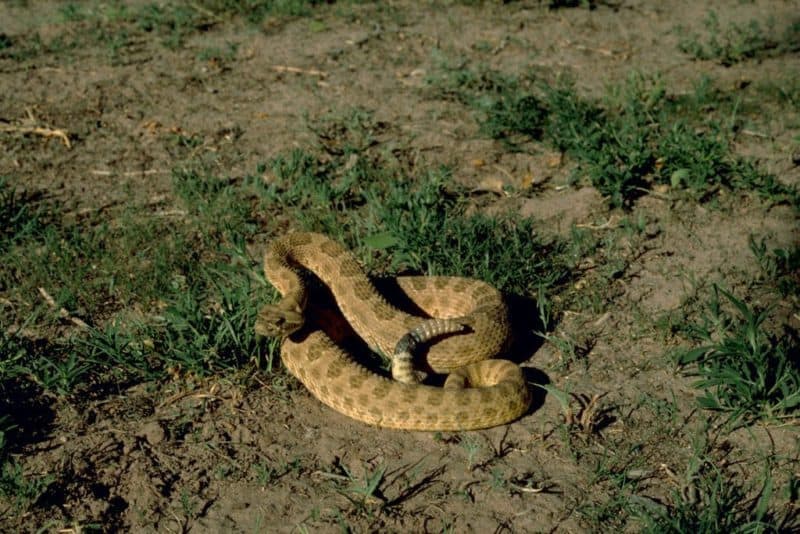
What Do Prairie Rattlesnakes Look Like?
| Size | *Adults typically measure about 3.3 feet (100 cm) in length. *The longest recorded specimen was just under 5 feet (151.5 cm) long. |
| Coloration | *Their base color varies and can be tan, olive green, or brown. |
| Dorsal Spots | *Brown blotches with darker borders are present on their bodies. |
| Head | *They have a triangular-shaped head with pit sensory organs on either side. *A light stripe runs diagonally from the back of each eye to the jaw. *Another stripe extends diagonally from below the eye to the corner of the mouth |
| Behavior | *Primarily ground-dwelling but occasionally climbs shrubs, bushes, or trees. |
| Conservation Status | *Common within their range in Oklahoma. Federally listed as a species of least concern. |
Where Do Prairie Rattlesnakes Live in New Oklahoma?
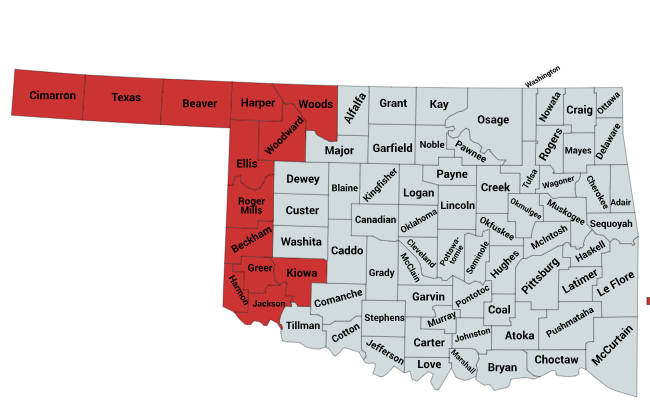
The Prairie Rattlesnake is found in the Oklahoma panhandle and down the state’s western side.
They live in grassland deserts and pine-oak forests.
How Dangerous Are Prairie Rattlesnakes?
Prairie rattlesnake venom is a mix of hemotoxins and myotoxins. Furthermore, according to some literature, it also has neurotoxins.
Prairie rattlesnake bites can have profound effects. The venom can cause severe pain. It may also induce shock, making the victim feel weak and disoriented. Swelling, blistering, and inflammation can occur at the bite site. Their venom can also damage red blood cells and impair blood clotting. In severe cases, the bite may result in severe tissue damage. There is also a risk of harm to internal organs.
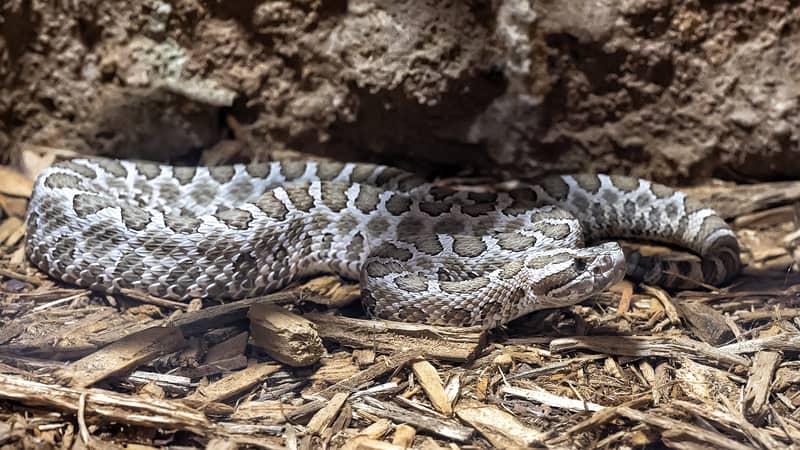
Western Massasauga Rattlesnakes (Sistrurus tergeminus)
What Do Western Massasauga Rattlesnakes Look Like?
| Size | *Adults range from 14 to 36 inches (36 cm to 91cm) long. |
| Coloration | *Their base color is light gray. *Younger snakes are paler than adults. |
| Dorsal Spots | *A row of large, rounded, dark brown spots run down their spine. *They have three smaller rows of spots down each side. *In some cases, the larger dorsal spots connect with the side spots, forming a large solid blotch. |
| Face | *They have a dark stripe on each side of their face and across their eye. |
| Conservation Status | *Vulnerable |
Where Do Western Massasaugas Live in Oklahoma?
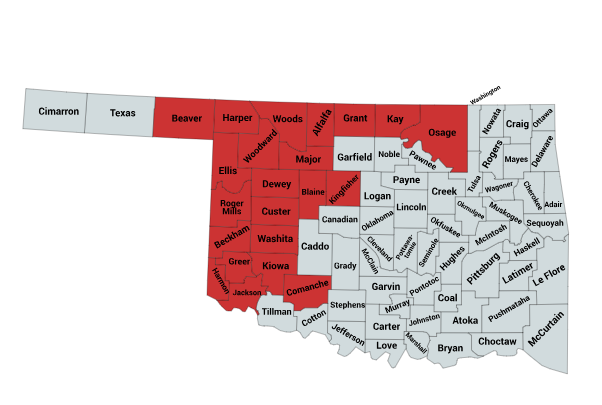
These snakes are found in mesic grasslands and prairie hillsides. The Western Massasauga can be found in northern and western Oklahoma.
How Dangerous Are Western Massasauga Rattlesnakes?
The venom of the Massasauga rattlesnake is cytotoxic. Cytotoxic venom destroys body tissue. Moreover, digestive enzymes in cytotoxic venom disrupt blood flow and prevent clotting. Massasauga bites to humans are rare. However, they do occur.
There are two documented deaths in Ontario from Eastern Massasauga envenomation. In each case, the victim did not receive antivenom in time.
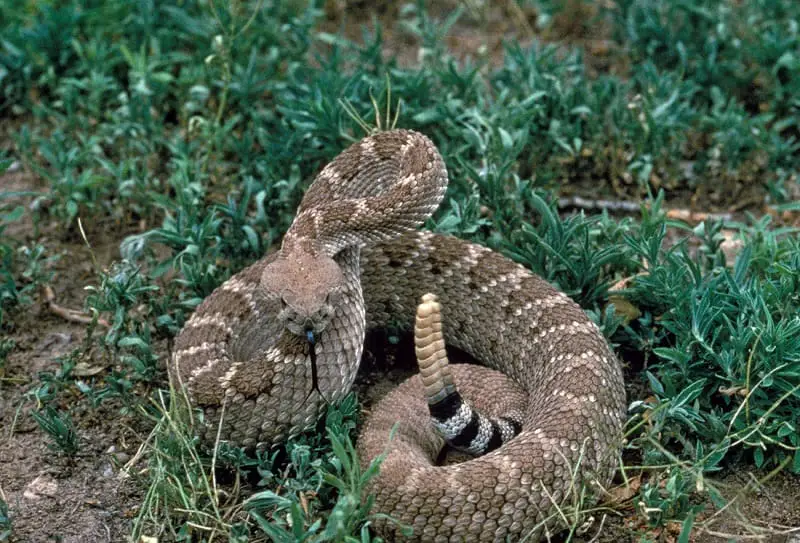
Western Diamondback Rattlesnake (Crotalus atrox)
This species has various names, including the Western Diamond-backed Rattlesnake and Adobe Snake.
What Do Western Diamondback Rattlesnakes Look Like?
| Size | Grows from 4 ft to 7 ft (1.22 to 2.13 m) in length. Average weight: 3 to 6 lb (1.23 to 2.7 kg) |
| Coloration | *Base colors: Yellow, light brown, salmon, gray, gray-brown, cream, or olive. *Dark diamond-shaped patterns along the back give it the name “Diamondback.” *A dark line runs from the corner of the mouth to behind the eye. |
| Dorsal spots | *Edges are darker than the base color. *Centers are slightly darker than the base color. |
| Head | *Features two to eight black bands above the rattle separated by pale gray bands. |
| Tail | *Features two to eight black bands above the rattle which are separated by pale gray bands. |
| Conservation Status | *Features two to eight black bands above the rattle separated by pale gray bands. |
Where Do Western Diamondback Rattlesnakes Live in Oklahoma?
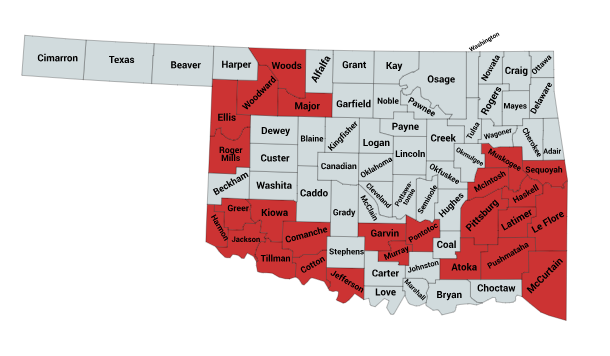
Western Diamondback Rattlesnakes are found all throughout Oklahoma. Their habitats include rocky canyons, plains, deserts, desert grasslands, and forests.
How Dangerous are Western Diamondback Rattlesnakes?
Western Diamondback Rattlesnake venom is Hemotoxic, cytotoxic, and myotoxic. If a Western Diamondback bite goes untreated, it can cause serious problems. These include severe internal bleeding and tissue damage, which might result in gangrene.
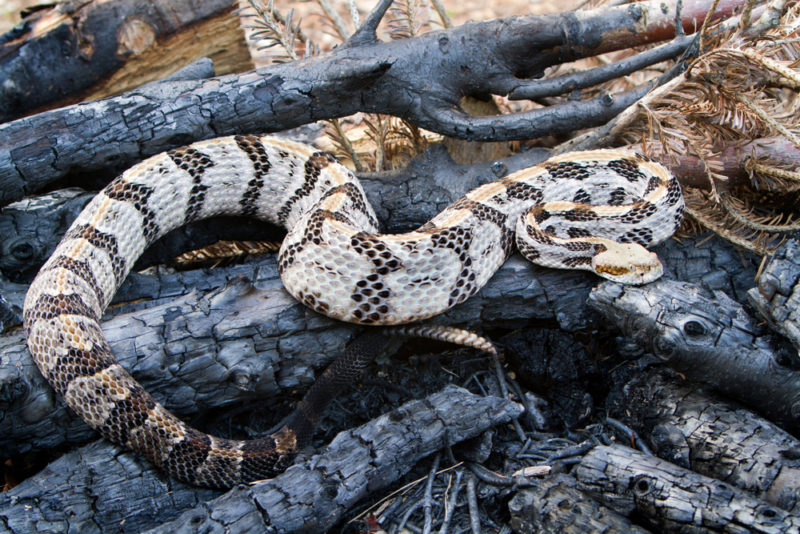
Timber Rattlesnake (Crotalus horridus)
Timber Rattler and Canebrake Rattlesnake are both common names for the Timber Rattlesnake. Generally, in higher-elevation habitats, they are called Timber Rattlesnakes. On the coastal plain, though, they’re called Canebrake Rattlesnakes.
What Do Timber Rattlesnakes Look Like?
| Size | *Average length: 36 to 60 inches (0.91 to 1.52 m). *Rare cases reported: Up to 7 feet (2.13 m). |
| Coloration | *General base color: Yellowish-brown to grey-brown. *Chevron pattern: Dark brown to black chevrons on their back and sides against a lighter base color. *Back stripe: Rusty to reddish stripe running down their back. *Tail color: Dark brown or black. |
| Melanistic Variation | *Some timber rattlesnakes exhibit a dark, melanistic color morph. *These snakes can appear almost entirely black. *The tail is darker than the rest of the body in this morph. |
| Behaviors | *These snakes are excellent climbers. In fact, timber rattlers have been found in trees at heights of more than 80 feet. *The experts have proven that timber rattlesnakes help control Lyme disease. This is because as they consume rodents, they’re also consuming ticks. A timber rattler will consume 2,500 to 4,500 ticks per year, depending on the location. |
| Conservation status | *Common within their range in Oklahoma. |
Where Do Timber Rattlesnakes Live in Oklahoma?
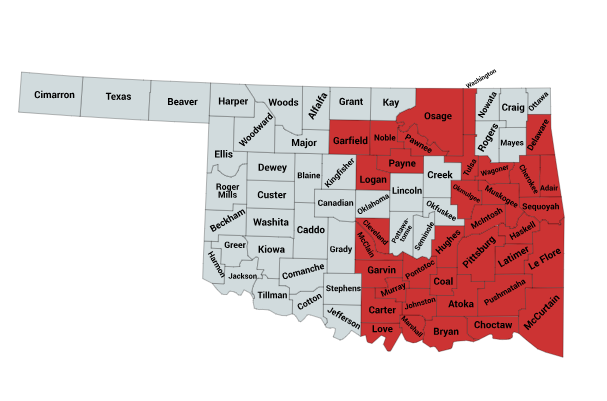
The Timber Rattlesnake lives in various habitats. These include deciduous forests, pine forests, swamps, farm fields, and river floodplains. These snakes are excellent climbers and have been found in trees at heights of more than 80 feet.
They are found in wooded areas in central to southeastern Oklahoma.
How Dangerous Are Timber Rattlesnakes?
- Timber Rattlesnakes are among the most dangerous in the United States. This is due to their long fangs and high venom yield. 1% to 10% of untreated Timber Rattlesnake bites result in a fatality.
- Fortunately, 40% to 60% of the time, they produce dry bites. In other words, although their fangs penetrate the body, they do not inject any venom.
- These snakes produce hemotoxic venom. Timber Rattlesnake bites sometimes cause serious complications. These include shock, seizures, coma, internal bleeding, and deep tissue damage.
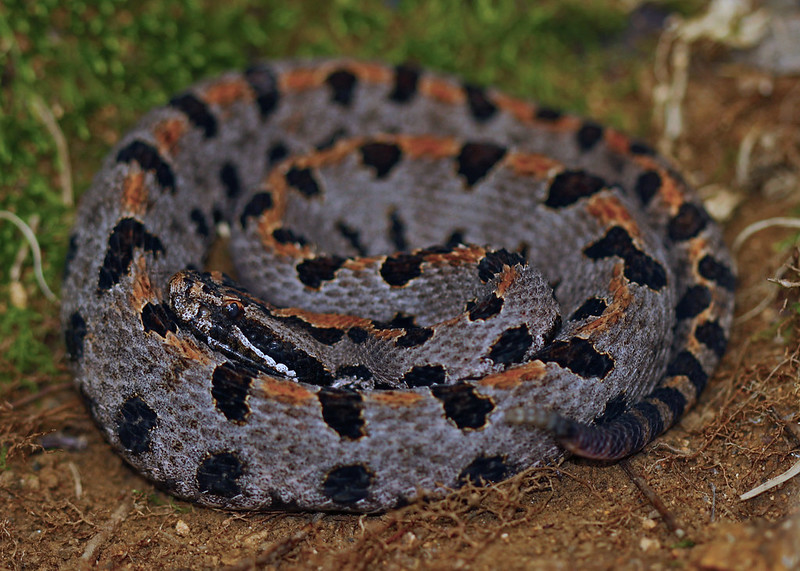
Western Pygmy Rattlesnake (Sistrurus miliarius streckeri)
Other common names for the Western Pygmy Rattlesnake are Ground Rattlesnake and Pygmy Rattlesnake.
What Do Western Pygmy Rattlesnake Look Like?
| Size | *Small, slender-tailed snake with a tiny rattle. *Length: 16 to 25 inches (41 to 64 cm). *Average length: 21.1 inches (54 cm). |
| Coloration and Markings | *Body: Light grayish brown with dark-colored blotches that form crossbars along the top and sides. *Stripe: Rust-colored vertical stripe on the back (may be absent in some individuals). *Belly: Cream-colored, often mottled. *Face: Distinct dark stripe from the corner of the mouth to the eye. |
| Rattle and Sound | *A tiny rattle produces a faint, grasshopper-like buzz. *Sound can only be heard from a few feet away. |
| Conservation Status | Least Concern |
Where Do Western Pygmy Rattlesnakes Live in Oklahoma?
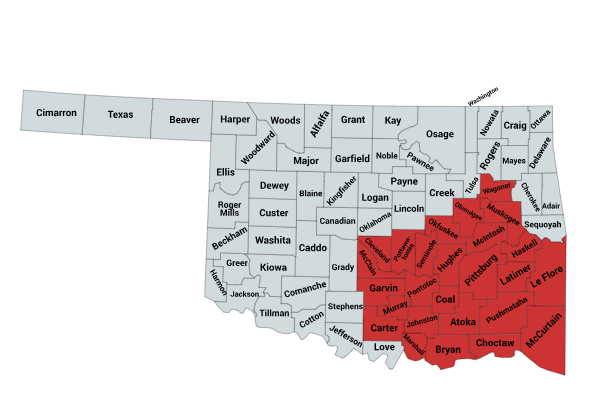
This species lives throughout much of south-eastern Oklahoma. They prefer sandhills, mixed forests, and floodplains near aquatic environments. They are rarely found in extremely dry habitats.
How Dangerous Are Western Pygmy Rattlesnakes?
Western Pygmy rattlesnakes have cytotoxic venom. By definition, cytotoxic venom destroys the body’s cells. This venom disrupts blood flow and prevents clotting with its digestive enzymes. Luckily, these snakes produce a small venom yield. A bite from a pygmy rattlesnake is unlikely to be fatal. However, any bite victim should still receive prompt medical attention.
Oklahoma’s Venomous Snakes in Winter: Insights into Brumation
During winter, Oklahoma’s snakes, like all reptiles, enter a dormant state called brumation—a hibernation-like period. Because snakes are ectothermic (cold-blooded) and cannot regulate their body temperature internally, they slow their metabolism and become inactive during the colder months.
Brumation Habits
- Solo vs. Communal Brumation: Some snakes brumate alone, while others gather in communal dens. For example, Eastern Copperheads and Timber Rattlesnakes often share dens, which may house up to 60 snakes.
- Mixed-Species Dens: Interestingly, these dens can include non-venomous species. It’s not uncommon to find Black Rat Snakes sheltering alongside venomous snakes.
Regional Variations
- Snakes may only seek shelter in warmer areas on the coldest winter days. They might not enter full brumation due to milder conditions.
Where Snakes Spend Winter
Snakes seek out protected spots to brumate, such as:
- Rock crevices
- Hollow logs
- Fissures on rocky hillsides
- They often choose south-facing slopes because these areas receive more sunlight, providing additional warmth during winter.
This natural adaptation allows Oklahoma’s venomous snakes to survive the winter and re-emerge when temperatures rise.
Avoiding Snake Bite
In Oklahoma, copperheads are responsible for the most venomous snake bites. These snakes rely on their excellent camouflage to stay hidden. They often remain perfectly still to avoid detection. If you’re walking in the woods and unknowingly get too close, a copperhead might not move, hoping you’ll pass by. Many bites happen when someone accidentally steps on the snake. To stay safe in snake habitats, always watch where you step and where you place your hands.
Another common cause of snake bite is attempts to capture or kill a snake. Remember, venomous snakes can strike instantly, delivering a potentially life-threatening bite. The safest approach is to keep a safe distance and leave them alone.
Dressing for Snake Country
- High-top leather boots and long pants are both wise ideas.
- Also, wear loose-fitting denim. If there’s a gap before the snake’s fangs touch your skin, your chances of being envenomated are lower.
- In the absence of high-top leather boots, some people wear snake gaiters.
Symptoms of Venomous Snake Bites
Some of the symptoms you may experience when a venomous snake bites you include:
- Discoloration in the area of the bite.
- Swelling in the area of the bite.
- Loss of muscle coordination.
- Tingling sensation in the area of the bite.
- Feeling nauseous.
- Having a faster heartbeat or rapid pulse.
What Should You Do if You Are Bitten?
If you or someone you are with has suffered a venomous snakebite, time is of the essence. Because the sooner a victim receives antivenom, the less chance the venom in their body has to cause harm. In other words, it is important to seek immediate medical treatment.
Do not attempt to kill the snake for identification purposes. This gives the snake a chance to bite you again. Also, consider that severed snakeheads can still bite and envenomate and often do. If you have a phone, take a picture of the offending reptile. Otherwise, get started on your way to the nearest hospital.
First Aid for Snake Bite Victims
- Remain calm and limit your movements. Do not run. If you must hike back to a vehicle, do it calmly and deliberately. Put as little stress on your heart as possible.
- Keep the area of the snake bite below the heart level and never above the heart level. Keeping the bite below the heart level will reduce the venom’s flow. However, holding the bite above your heart level will increase the venom’s flow.
- Remove all constricting items such as bracelets, watches, or rings before swelling occurs.
- Remember that using a cold compress on a venomous snake bite is not advisable. The cold may cause the local blood vessels to constrict and spread the venom faster.
- You can wash the affected area like any other wound with soap and water.
- You may cover the bite area with a moist dressing to reduce the swelling.
- Get medical attention as soon as possible. Call the hospital to tell them a venomous snake has bitten you. So they can have antivenom ready to give you when you arrive.
- A person whom a venomous snake has bitten may go into shock. If this happens, lay them flat and cover them with a blanket.
Conclusion
The eight species of venomous snakes in Oklahoma play a critical role in maintaining the state’s ecosystem. They do this by keeping rodent populations in check.
These fascinating reptiles are also potentially dangerous to humans. Understanding their behaviors, habitats, and the steps to avoid dangerous encounters will make you safer in snake country.
Remember, awareness is the first line of defense. Learn to recognize these snakes, dress appropriately for outdoor activities, and always watch where you place your feet and hands in snake-prone areas. If a snakebite occurs, prioritize staying calm, following first-aid protocols and seeking immediate medical attention.
By respecting these remarkable reptiles and their role in nature, you not only protect yourself but also contribute to preserving Oklahoma’s unique biodiversity. Whether you’re an outdoor enthusiast or simply live in snake territory, knowledge is the key to staying as safe as possible while appreciating the natural world around you.
Recent Posts
The only venomous snakes in Washington State are Northern Pacific Rattlesnakes. The Northern Pacific Rattlesnake (Crotalus oreganus oreganus) is a sub-species of the Western Rattlesnake. Anyone...
Skunks are not classified as true hibernators. But they go into a state of torpor when the weather gets cold. Skunks are light sleep hibernators, along with opossums, bears, and raccoons. ...
